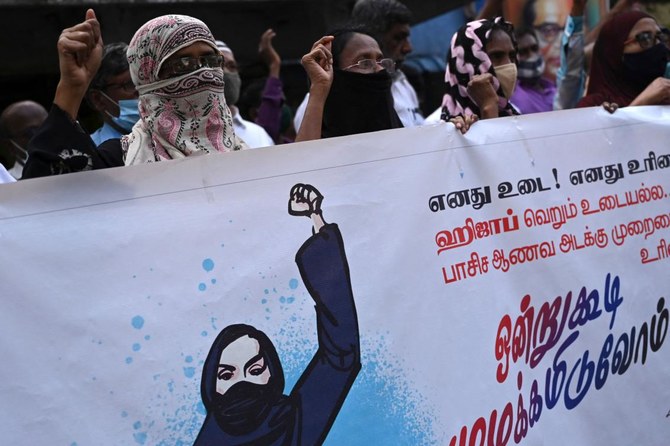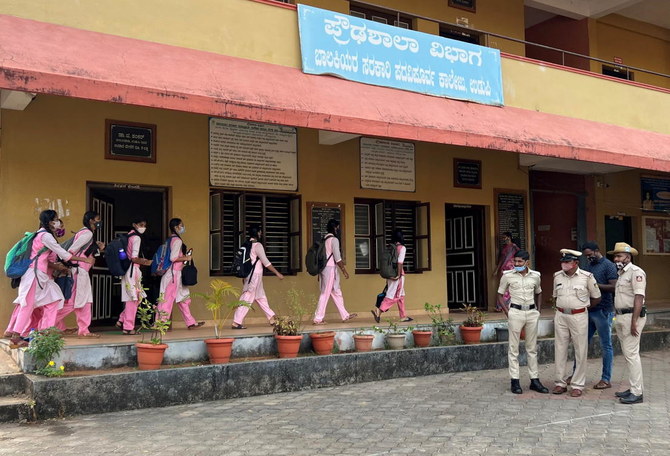LUCKNOW: A dispute over restrictions on the wearing of the hijab by female students in a southern Indian state has now reached India’s most populous state of Uttar Pradesh, with a group of youngsters asking a college to ban the head covering.
Authorities closed colleges in Karnataka in India’s south last week after a new uniform policy barred students from wearing headscarves in classrooms, leading to protests by Muslim students and counter protests by Hindu students.
Muslims have criticized the ban as another way of marginalizing a community that accounts for about 13 percent of Hindu-majority India’s 1.35 billion people.
In Uttar Pradesh, in the country’s north and bordering New Delhi, a group of more than two dozen young men reached the Dharma Samaj College in Aligarh district on Monday and handed a memorandum to its officials seeking a complete ban on the hijab within its compound.
They had saffron shawls around their necks — typically worn by Hindus — said the college’s chief proctor, Mukesh Bharadwaj, adding he did not recognize the people. Currently, religious garb is not allowed in classrooms, but can be worn elsewhere on campus.
“Two years ago the same issue was raised and it has been raised again. We do not allow any type of religious uniform and we have a civil code of uniform for everyone,” Bharadwaj told Reuters by phone on Tuesday.
“There is a changing room for girls and they can change their dress there before attending class,” he said. “We are investigating the matter.”
Uttar Pradesh, estimated to have as many people as Brazil, is ruled by a Hindu monk from Prime Minister Narendra Modi’s party and is in the midst of a multi-phase election that ends next month. Hindu-Muslim disputes are often used for political gains in the state.
The hijab issue has already reached court in Karnataka. Hearings will resume on Tuesday on whether the hijab should be allowed in class.
India’s hijab dispute reaches its most populous state
https://arab.news/bp3yz
India’s hijab dispute reaches its most populous state

- Authorities closed colleges in Karnataka last week after policy barred students from wearing hijabs in classrooms
- Muslims have criticized the ban as another way of marginalizing minority community
Mystery of CIA’s lost nuclear device haunts Himalayan villagers 60 years on

- Plutonium-fueled spy system was meant to monitor China’s nuclear activity after 1964 atomic tests
- Porter who took part in Nanda Devi mission warned family of ‘danger buried in snow’
NEW DELHI: Porters who helped American intelligence officers carry a nuclear spy system up the precarious slopes of Nanda Devi, India’s second-highest peak, returned home with stories that sent shockwaves through nearby villages, leaving many in fear that still holds six decades later.
A CIA team, working with India’s Intelligence Bureau, planned to install the device in the remote part of the Himalayas to monitor China, but a blizzard forced them to abandon the system before reaching the summit.
When they returned, the device was gone.
The spy system contained a large quantity of highly radioactive plutonium-238 — roughly a third of the amount used in the atomic bomb dropped by the US on the Japanese city of Nagasaki in the closing stages of the Second World War.
“The workers and porters who went with the CIA team in 1965 would tell the story of the nuclear device, and the villagers have been living in fear ever since,” said Narendra Rana from the Lata village near Nanda Devi’s peak.
His father, Dhan Singh Rana, was one of the porters who carried the device during the CIA’s mission in 1965.
“He told me there was a danger buried in the snow,” Rana said. “The villagers fear that as long as the device is buried in the snow, they are safe, but if it bursts, it will contaminate the air and water, and no one will be safe after that.”
During the Sino-Indian tensions in the 1960s, India cooperated with the US in surveillance after China conducted its first nuclear tests in 1964. The Nanda Devi mission was part of this cooperation and was classified for years. It only came under public scrutiny in 1978, when the story was broken by Outsider magazine.
The article caused an uproar in India, with lawmakers demanding the location of the nuclear device be revealed and calling for political accountability. The same year, then Prime Minister Morarji Desai set up a committee to assess whether nuclear material in the area near Nanda Devi could pollute the Ganges River, which originates there.
The Ganges is one of the world’s most crucial freshwater sources, with about 655 million people in India, Nepal, and Bangladesh depending on it for their essential needs.
The committee, chaired by prominent scientists, submitted its report a few months later, dismissing any cause for concerns, and establishing that even in the worst-case scenario of the device’s rupture, the river’s water would not be contaminated.
But for the villagers, the fear that the shell containing radioactive plutonium could break apart never goes away, and peace may only come once it is found.
Many believe the device, trapped within the glacier’s shifting ice, may have moved downhill over time.
Rana’s father told him that the device felt hot when it was carried, and he believed it might have melted its way into the glacier, remaining buried deep inside.
An imposing mass of rock and ice, Nanda Devi at 7,816 m is the second-highest mountain in India after Kangchenjunga.
When a glacier near the mountain burst in 2021, claiming over 200 lives, scientists explained that the disaster was due to global warming, but in nearby villages the incident was initially blamed on a nuclear explosion.
“They feared the device had burst. Those rescuing people were afraid they might die from radiation,” Rana said. “If any noise is heard, if any smoke appears in the sky, we start fearing a leak from the nuclear device.”
The latent fear surfaces whenever natural disasters strike or media coverage puts the missing device back in the spotlight. Most recently, a New York Times article on the CIA mission’s 60th anniversary reignited the unease.
“The apprehensions are genuine. After 1965, Americans came twice to search for the device. The villagers accompanied them, but it could not be found, which remains a concern for the local community,” said Atul Soti, an environmentalist in Joshimath, Uttarakhand, about 50 km from Nanda Devi.
“People are worried. They have repeatedly sought answers from the government, but no clear response has been provided so far. Periodically, the villagers voice their concerns, and they need a definitive government statement on this issue.”
Despite repeated queries whenever media attention arises, Indian officials have not released detailed updates since the Desai-appointed committee submitted its findings.
“The government should issue a white paper to address people’s concerns. The white paper will make it clear about the status of the device, and whether leakage from the device could pollute the Ganges River,” Soti told Arab News.
“The government should be clear. If the government is not reacting, then it further reinforces the fear.”















